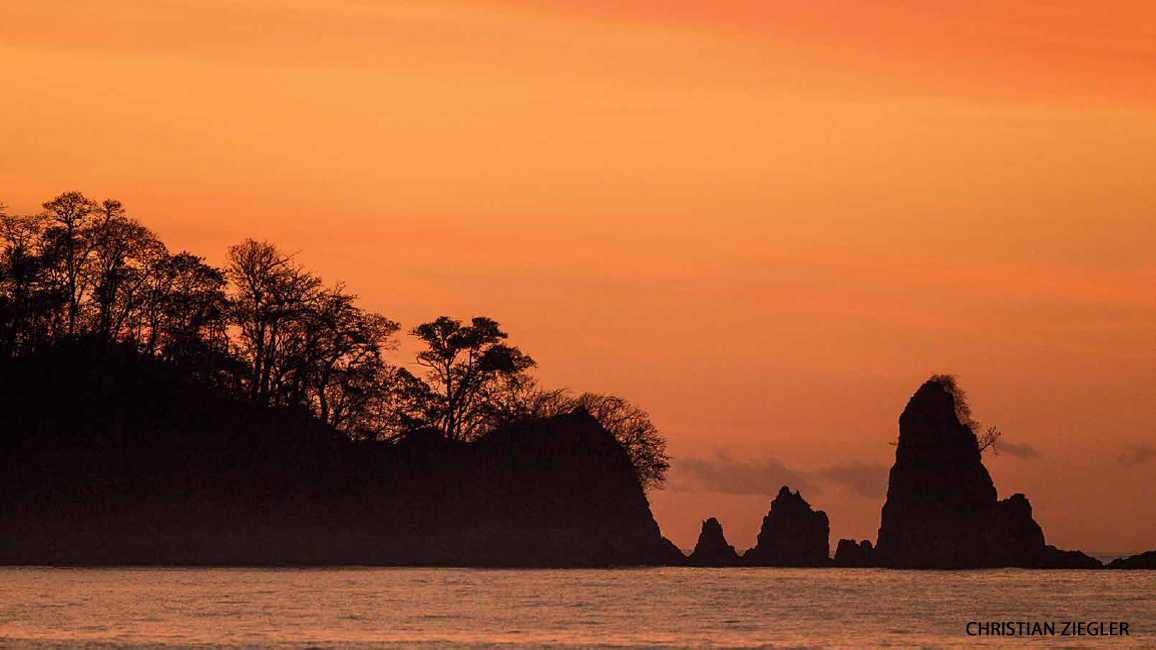
Island of the Lost
By Hannah Schardt; photos by Christian ZieglerA lush island rises out of a clear, blue sea. It bristles with towering trees and slopes down to golden, sandy beaches. Shouldn’t this place be swarming with people? Not when it’s Coiba (COH-ee-bah), the largest island in Central America! No people at all live on Coiba. And for many years, the animals and plants on this island were “lost”—almost completely unstudied by scientists. Want to find out why this island was a mystery for so long—and why scientists are just now learning its secrets? Come ashore!

PARADISE OR PRISON?
Coiba, off the coast of Panama, is a quiet, peaceful place today. But it has a harsh past. For nearly 100 years, it was home to a prison. As many as 3,000 prisoners once lived on the island, along with guards and other prison workers. Hardly any other people visited. So the island’s ancient tropical forests went mostly unexplored.
In 2004, the prison shut down for good. All the people moved off the island, leaving behind a few empty buildings. Those buildings are now falling apart. Their roofs have rotted away, and vines cover the walls. That’s no problem for the living things that call the island home: the monkeys, lizards, frogs, bats, bees, and other wild animals that have been there for thousands of years!
These days, Coiba and the smaller islands around it make up a national park. And scientists are finally able to visit. They are learning more about Coiba’s “lost” wild creatures—including some that are found nowhere else on Earth.
Coiba’s abandoned prison—penitenciaria in Spanish—is now crumbling and covered in vines.
The Coiba howler monkey (above) lives only in Panama.

KEEP OUT!
For many years, Coiba had a reputation as a scary place. First of all, there was the prison. Not many prisoners lived inside the walls of the prison buildings. Most stayed in camps around the island. (The buildings were mostly houses for prison staff.) Even though they lived outside, the inmates rarely tried to escape. After all, they were on a wild island, surrounded by miles of ocean—and hungry sharks! Even after the prison closed, people stayed away. Some believed the island was haunted. Others were afraid of the venomous snakes that lived in its forest or the sharks that swam just offshore. So Coiba was pretty much left alone.
In some other parts of Panama, almost all of the forest was cut down to make room for farms, ranches, and houses. But Coiba’s forest stayed frozen in time—great news for the animals that called it home.
TAKE COUNT
A few years ago, a wildlife photographer and scientist named Christian Ziegler decided to find out exactly which plants and animals lived on Coiba. (Christian took all the photos in this story.) He gathered a bunch of scientists from around the world on the island. They included experts on plants, insects, birds, reptiles, and bats. It was time for a very wild kind of census: a bioblitz!
Even the tiniest animals count—and get counted! An ant expert climbs to the top of a tree to look for ants and other insects.
A vine snake ripples its ribbon-like body out from a tree branch.
A jewel-like orchid bee rests on a fungus in the Coiba forest.
A yellow-headed caracara flaps its wings to warn off a photographer: Don’t get any closer!
The extra-long tongue on this rufous-tailed hummingbird is just right for sipping nectar from long, skinny flowers.
Coiba’s prison closed only 15 years ago. But it already looks like an ancient ruin!

READY. . .SET. . .BIOBLITZ!
A bioblitz is when people try to count as many species as they can find in an area during a set period of time. During the Coiba Bioblitz, the scientists spent a month exploring the island. They climbed trees. They swam in the ocean. They hiked deep into the forest. And everywhere they went, they paid close attention to the plants and animals they saw.
And they saw a LOT of plants and animals! During those few weeks, scientists counted 172 kinds of birds, 39 kinds of bats, 5 kinds of sea turtles, and 70 kinds of ants. They also spotted a large rodent found only on this island: the Coiban agouti. They even discovered a “new” plant that had never been seen anywhere by scientists!
KEEPING COIBA SAFE
The scientists weren’t counting Coiba’s plants and animals only because they were curious. They also wanted to show the world that Coiba is a place worth saving. Even though the island is part of a national park, some of Panama’s politicians don’t want to keep it protected. With the prison closed, more people are interested in visiting the island—and in making money from it. Some want to fish in places where fishing isn’t allowed. Others want to cut down trees for lumber or to clear space for houses or businesses. Some people even want to build a runway for Airplanes right through Coiba’s ancient forest.
So the scientists who study Coiba are trying to spread an important message. Now that this “lost island” is no longer lost, we should keep its wild treasures safe and protected forever.
At sunset, a young boa winds itself around a tree.
After dark, this Pacific land crab scuttles along the sandy shore.
This delicate plant looks a bit like an orchid. But it’s a member of the bean family!
Scientists trapped this smoky jungle frog so they could test it for diseases. Good news: It’s healthy!
Off you go! A scientist releases a bat after examining it during the Coiba Bioblitz.
















